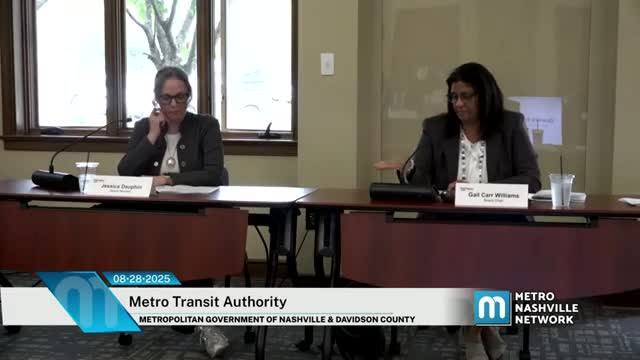Nashville Transit Reports Increased Ridership on Routes 34 and 41 in Second Quarter 2025
August 29, 2025 | Transit Authority Meetings, Nashville, Davidson County, Tennessee
This article was created by AI summarizing key points discussed. AI makes mistakes, so for full details and context, please refer to the video of the full meeting. Please report any errors so we can fix them. Report an error »

The Metro Transit Authority's recent meeting highlighted significant trends in ridership for the second quarter of 2025, revealing a 2% increase compared to the same period last year. However, this growth was unevenly distributed across various routes, reflecting the impact of service changes implemented in March 2024.
One of the standout performers was Route 34 Opry Mills, which experienced an impressive 11% increase in ridership, particularly on Saturdays where numbers surged by 20%. In response to the challenges of maintaining timely service on weekends, officials are considering adding an additional bus to enhance frequency and reliability.
Route 41 Golden Valley also saw remarkable growth, with a 45% increase in ridership attributed to its transition from a peak-only service to hourly operations throughout the day. This change has improved access for passengers seeking employment at nearby UPS and FedEx facilities. Additionally, requests for extended service hours, particularly for night classes at the Nashville Auto Diesel College, are prompting discussions about further adjustments to the route.
Conversely, Route 23 Dickerson Pike reported a decline in ridership, particularly among peak users, indicating a potential shift in commuting patterns. This decrease is partly linked to a drop in student ridership, which accounts for about 50% of the decline during school months. In contrast, Route 56 experienced a growth of over 7%, with notable increases in evening ridership following the addition of more frequent service.
The WeGoLink service, while still in its early stages, saw a remarkable 300% increase in ridership, primarily within existing zones. The introduction of new zones contributed minimally to this growth, with the South Nashville area benefiting from free service during a major construction project. This zone, along with Antioch, now represents a significant portion of the program's ridership, although overall numbers remain modest.
The discussions during the meeting underscored the importance of adapting transit services to meet the evolving needs of the community. As ridership patterns shift, the Metro Transit Authority is poised to make further adjustments to enhance service quality and accessibility, particularly in response to job access and educational opportunities. The anticipated changes will be closely monitored to ensure they effectively address the demands of Nashville's growing population.
One of the standout performers was Route 34 Opry Mills, which experienced an impressive 11% increase in ridership, particularly on Saturdays where numbers surged by 20%. In response to the challenges of maintaining timely service on weekends, officials are considering adding an additional bus to enhance frequency and reliability.
Route 41 Golden Valley also saw remarkable growth, with a 45% increase in ridership attributed to its transition from a peak-only service to hourly operations throughout the day. This change has improved access for passengers seeking employment at nearby UPS and FedEx facilities. Additionally, requests for extended service hours, particularly for night classes at the Nashville Auto Diesel College, are prompting discussions about further adjustments to the route.
Conversely, Route 23 Dickerson Pike reported a decline in ridership, particularly among peak users, indicating a potential shift in commuting patterns. This decrease is partly linked to a drop in student ridership, which accounts for about 50% of the decline during school months. In contrast, Route 56 experienced a growth of over 7%, with notable increases in evening ridership following the addition of more frequent service.
The WeGoLink service, while still in its early stages, saw a remarkable 300% increase in ridership, primarily within existing zones. The introduction of new zones contributed minimally to this growth, with the South Nashville area benefiting from free service during a major construction project. This zone, along with Antioch, now represents a significant portion of the program's ridership, although overall numbers remain modest.
The discussions during the meeting underscored the importance of adapting transit services to meet the evolving needs of the community. As ridership patterns shift, the Metro Transit Authority is poised to make further adjustments to enhance service quality and accessibility, particularly in response to job access and educational opportunities. The anticipated changes will be closely monitored to ensure they effectively address the demands of Nashville's growing population.
View full meeting
This article is based on a recent meeting—watch the full video and explore the complete transcript for deeper insights into the discussion.
View full meeting
